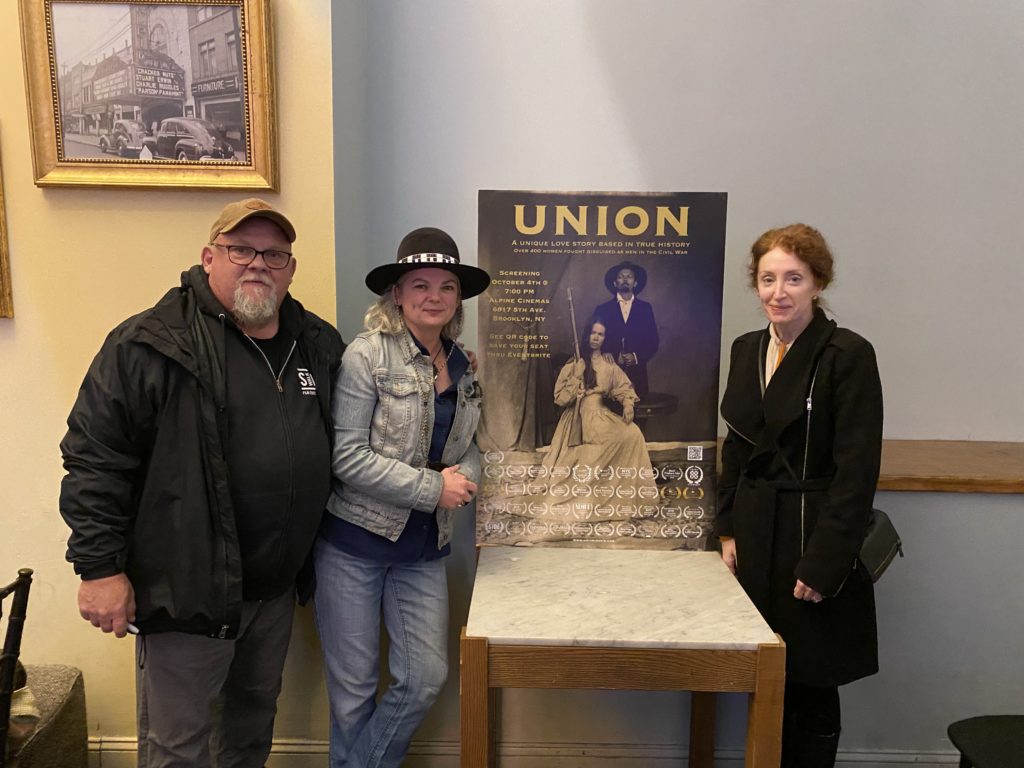From brooklyneagle.com
Brooklyn history and American history converged on Oct. 5 as Bay Ridge’s storied Alpine Cinema hosted a special showing of “Union,” a Civil War film which local resident Whitney Hamilton both directed and starred in.
The film, a 20-year labor of love for Hamilton, enjoyed a one-night screening at the Alpine – at 101 years old, the oldest continuously operating movie theater in New York City – thanks in large part to the efforts of Victoria Hofmo, the president of the Bay Ridge Arts & Cultural Alliance (BRACA).

The theater’s restoration was also a labor of love for its owner, Nick Nicolaou, who bought the Alpine and restored it 16 years ago, at a time when area residents feared it would be demolished.
“It’s the last of its kind in New York,” he said.
“The neighborhood movie theater is more important than people think,” Nicolaou told this paper, stressing that, over the years, “Ninety percent of them have shut down, one way or another. We’re all better off if we keep some of them. They give character to the neighborhood.”
And, he added, it benefits not only residents but merchants. “Everybody has more business when a neighborhood Main Street theater is open,” Nicolaou said.
When Nicolaou bought the Alpine, he recalled, it had been on the market for about a year, and larger cinema companies had shown no interest. Had he not bought the theater, Nicolaou contended, it was very likely that it would have become something else – “another drugstore or supermarket” – as other old movie theaters have. “I couldn’t let that happen.”
Noting that he had emigrated to the United States when he was 12, Nicolaou said, “My education is working in movie theaters since I was 15 years old. That turned my life around from being a poor immigrant.”
Nicolaou, who charges just $10 admission for adults at the Alpine because he believes so strongly in the place of a movie theater at the center of community life, was happy to open the Alpine for the special screening, celebrating the work of current and past local residents.
“Union” tells the story of a woman who impersonated a man to fight in the Civil War (there were approximately 400 women who did exactly that, according to Hamilton), and who continued to live as a man even off the battlefield.
In “Union,” based on Hamilton’s novel “Firefly,” it is Grace Kieler who takes on the identity of her dead brother Henry and fights as him, later marrying the widowed Virginia Klaising, who had saved Kieler after the bloody battle of Antietam, and whose brother is attempting to pressure her into agreeing to an unwanted marriage with an older man.
The unusual union, helped along by nearby Cherokee mountain-dwellers, endures against the odds, adding a third member, a young boy whom Kieler had promised to care after the death of his mother, Georgianna Hayes, played by actor Judy Krause. Eventually, the blended family becomes legendary in the Blue Ridge Mountains, where the tale is set.

The story of the film’s production, the active part of which spanned from 2016 through 2018, is almost as dramatic as the film itself. Hamilton, who is originally from Alabama (where “Union” was filmed) and who has both Cherokee and Scandinavian ancestors, spent years embedding with various Civil War reenactor groups, where she had to pass as a man in order to participate.
During reenactments, “You can’t be identified as a woman on the field,” Hamilton told the screening attendees during a question-and-answer period that followed the showing. If you are, she stressed, “They’ll throw you off. So, I really did have to pass to get on the field on a horse.” Among the numerous reenactments in which she participated was the one marking the 150th anniversary of the Battle of Gettysburg.
The photographers experienced many challenges, as well. Producer Patrick Sullivan, who was born and brought up in Bay Ridge — and who has fond memories of the Alpine, where his grandmother sold tickets — explained that shooting battle scenes required those behind the cameras “to dress up as soldiers” and camouflage their equipment.
The battle scenes themselves – which are stylized and elegant, often in slow motion that showcases the brutality of war while providing a suitable backdrop for the unusual love story – were filmed using reenactors rather than professional actors, creating its own set of challenges.

“Horrible things are happening, but there’s still such beauty in the film,” Hofmo remarked.
Sullivan credited Cinematographer Bill Schweikert’s use of Russian lenses from the 1940s as being a key element in how the film looks.
“Union,” which was originally released at a series of film festivals in 2018 and 2019, can be seen via various video on demand services.
According to cinematreasures.org, the Alpine – which was originally owned by Loew’s — opened its doors on June 6, 1921, and showed silent movies, with a 12-piece orchestra providing music. In its original incarnation, as designed by Carlson & Wiseman, on a single level, it seated 2,200 patrons, who paid between 15 and 25 cents admission, depending on the time of day and the day of the week.

In 1976, according to cinematreasures.org, it was divided into two theaters, and 10 years later, was again divided into seven different screening areas, with an eighth added nearly two decades later.
A subsequent renovation by Nicolaou – which involved removing a drop ceiling that had been added in the 1980s — uncovered molded detailing in the lobby area dating to the 1920s which he had restored.
The Alpine Cinema is located at 6817 Fifth Avenue.

 Coney Island casino opponents respond to city council’s vote to approve rezoning area
Coney Island casino opponents respond to city council’s vote to approve rezoning area  Officer honored for community involvement during Mass for American Independence Day Parade
Officer honored for community involvement during Mass for American Independence Day Parade